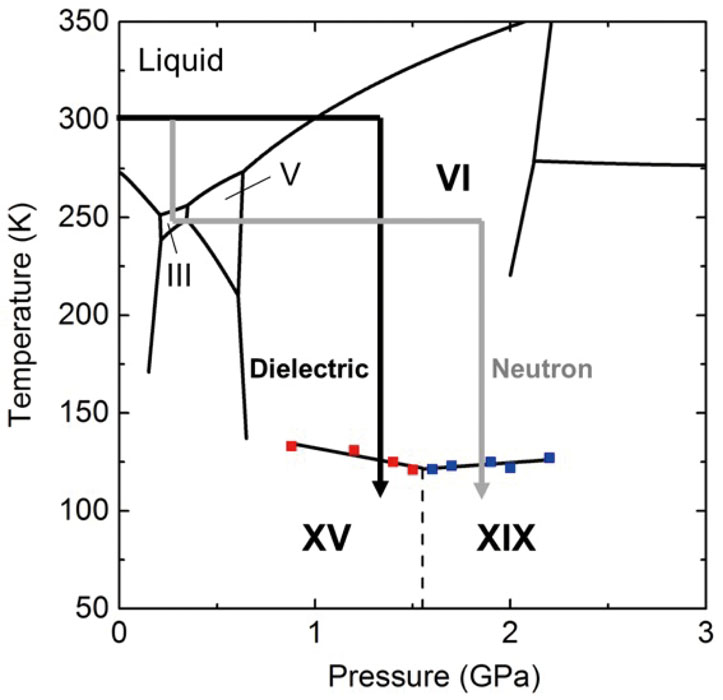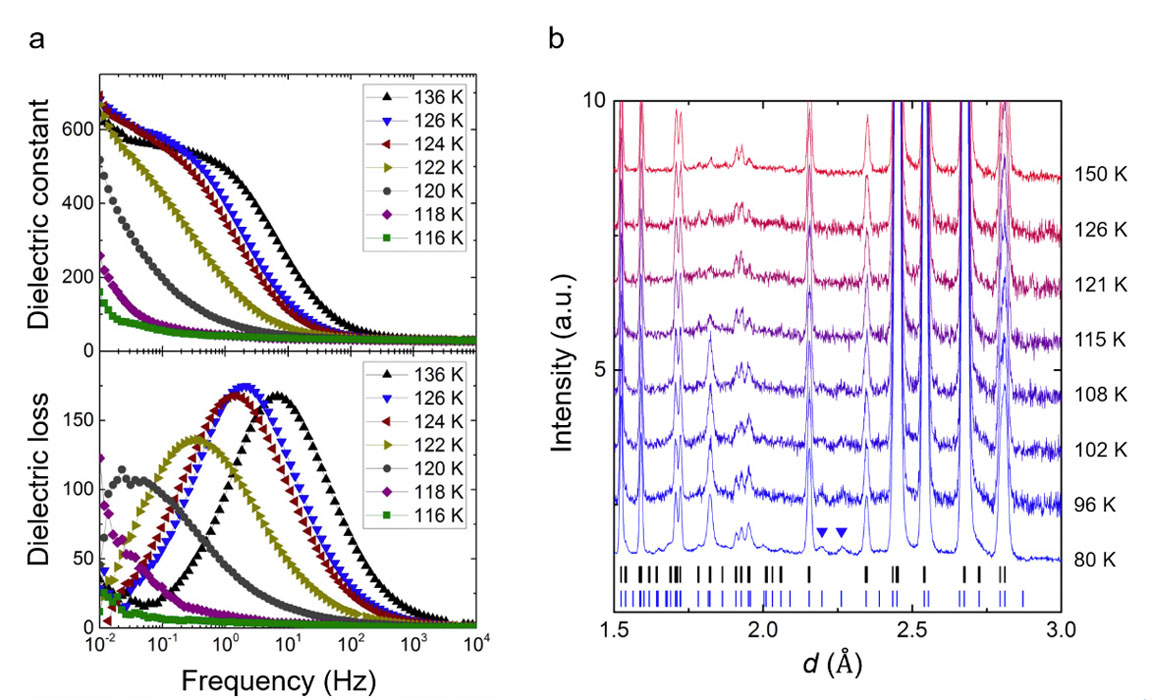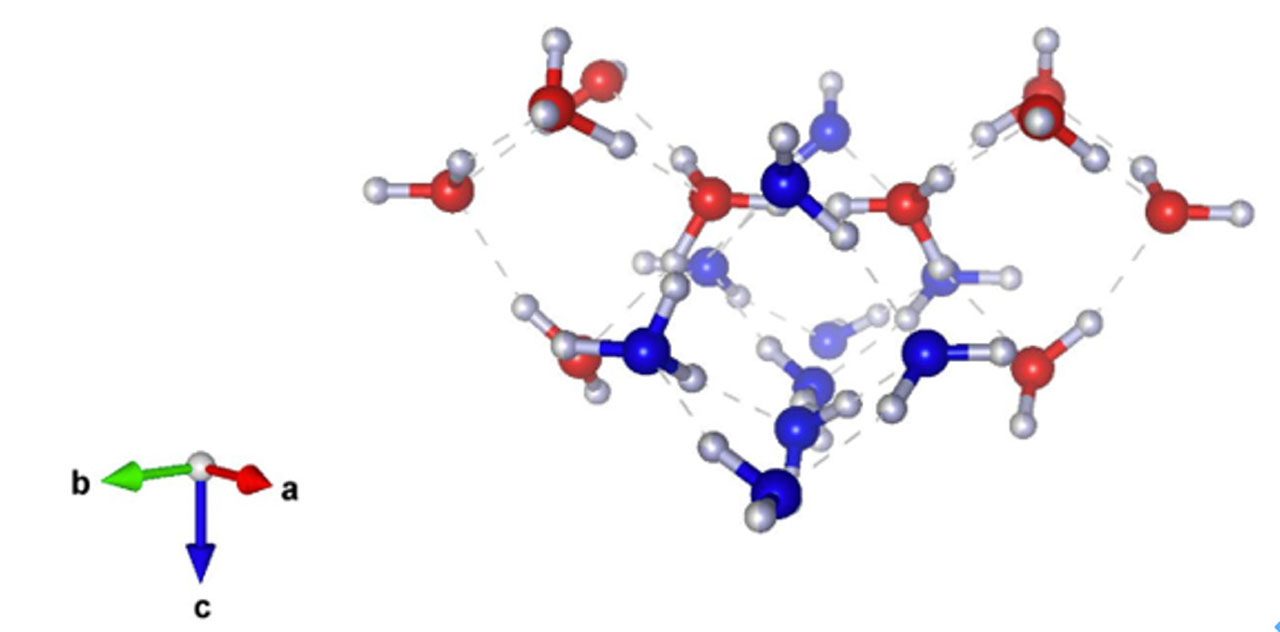Second Hydrogen-Ordered Phase of Ice VI: Ice XIX
R. Yamane, K. Komatsu, and Y. Uwatoko
Ice exhibits extraordinary structural variety in its polymorphic structures. To date, more than 20 crystalline and amorphous phases of ice have been reported.
The existence of a new form of diversity in ice polymorphism has recently been debated in both experimental and theoretical studies, questioning whether hydrogen-disordered ice can transform into multiple hydrogen-ordered phases, contrary to the known one-to-one correspondence between disordered ice and its ordered phase. Recent experiments on a high-pressure hydrogen-disordered phase, ice VI, revealed an unknown hydrogen-ordered form besides the known ordered phase, ice XV. However, due to experimental difficulties under the high-pressure condition, the intriguing manner of hydrogen ordering in ice VI has been investigated only using decompressed sample to ambient pressure. Also, no previous study reports direct experimental evidence for the multiplicity of hydrogen-ordered phase of ice VI. We report a second hydrogen-ordered phase for ice VI, ice XIX, unambiguously demonstrated by in-situ dielectric and neutron diffraction measurements under high pressure originally developed by our group [1]. Based on a newly obtained phase diagram of ice VI, XV and XIX (Fig. 1), we revealed that ice XIX is thermodynamically stabilized by pressure compared to ice XV.

Fig. 1. Representative experimental paths of dielectric and neutron diffraction experiments described in the phase diagram of ice obtained herein. Phase boundaries among ice VI, ice XV, and ice XIX are described by black solid lines, based on dielectric experiments (red and blue squares correspond to phase transition temperatures from ice VI to ice XV and XIX, respectively). The dotted line shows the provisional phase boundary between ice XV and ice XIX.
To investigate hydrogen ordering of ice VI in its stable pressure region, comprehensive dielectric experiments were first carried out in the pressure range 0.88–2.2 GPa, using a newly developed pressure cell. Ice VI was initially obtained at room temperature and its dielectric properties were determined in both cooling and heating runs in the temperature range 100–150 K. Neutron diffraction experiments were conducted at 1.6 and 2.2 GPa, in which ice XIX appears as hydrogen-ordered phase of ice VI based on the dielectric experiments, using Mito-system at J-PARC [2]. Both cooling and heating runs were conducted at each pressure in the temperature range 80–150 K.
Phase transitions from ice VI to its hydrogen-ordered phases were observed at around 120–130 K, along with sudden weakening of the dielectric response of ice VI with decreasing temperature (Fig. 2a). The reason for this weakening is that hydrogen ordering of ice suppresses reorientation of water molecules which induces the dielectric response of ice. The transition from ice VI to ice XIX was also observed in the neutron diffraction experiments, as appearance of new peaks due to symmetry lowering (Fig. 2b). Some of the new peaks, e.g. those at 2.20 Å and 2.26 Å (indicated by blue triangles in Fig. 2b), cannot be explained by the structure of ice XV. This is unambiguous evidence that ice VI has a hydrogen-ordered phase distinct from ice XV, and we named this unknown phase as ice XIX.

Fig. 2. a Dielectric constant and dielectric loss of HCl-doped ice VI and its hydrogen-ordered phase (ice XIX) obtained at 1.9 GPa upon cooling. b Neutron diffraction patterns of ice VI and XIX obtained at 1.6 GPa in the cooling run. Only an expanded area showing new peaks of ice XIX is displayed. The blue and black ticks represent all the peak positions expected from the unit cells of ice XIX and ice XV, respectively. Blue triangles indicate new peaks at 2.20 Å and 2.26 Å, which do not appear from the unit cell of ice XV.
Based on the phase boundary of ice VI and its hydrogen-ordered phases, ice VI contracts upon hydrogen ordering, which thermodynamically stabilizes ice XIX in the higher-pressure region compared to ice XV because of its smaller volume than ice XV.
In addition, from our structural analysis, two structural models, whose space groups are P4 and Pcc2, are the most plausible for the crystal structure of ice XIX (the Pcc2 structural model is shown in Fig. 3). It should be noted that the proposed structure models intrinsically include hydrogen atoms whose site occupancy is 50 %; in other words, the models exhibit that ice XIX is partially ordered state. This indicate a possibility that there exists another fully hydrogen-ordered phase of ice VI instead of the partially hydrogen-ordered ice XIX considering the third law of thermodynamics. Considering the suggested space group of ice XV, P1 or Pmmn, centrosymmetry of hydrogen configurations is the most significance difference in hydrogen configuration between ice XIX and ice XV. Such symmetry difference would induce intriguing difference of physical properties between ice XIX and XV in terms of such as optic and dielectric.
References
- [1] R. Yamane, K. Komatsu, J. Gouchi, Y. Uwatoko, S. Machida, T. Hattori, H. Ito, and H. Kagi, Nat. Commun. 12, 1129 (2021).
- [2] K. Komatsu, M. Moriyama, T. Koizumi, K. Nakayama, H. Kagi, J. Abe, and S. Harjo, High Press. Res. 33, 208 (2013).

